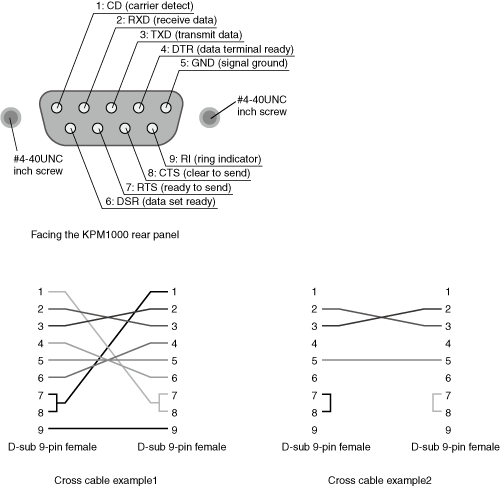Setup
Interface Setup
RS232C (Standard Equipped)
RS232C connection
Turn off the POWER switch on the KPM1000 and the computer.
Use a D-sub 9-pin female-to-female AT type cross cable for the RS232C cable. Figure shows the connector pin assignments.
The KPM1000 does not use hardware handshaking (Cross cable example2).

9-pin AT type connector
RS232C configuration
1. Press I/F.
"SELECt" is displayed in the settings.
2. Press DISP D until "rS-232C" is displayed.
3. Press DISP C until "bit.P.SEC" is displayed.
4. Press the Δ∇ or DISP D to select the baud rate.
You can set the baud rate to 2400, 4800, 9600, 19200, or 38400 (the unit is BPS).
5. Press DISP C until "Flo.Cont" is displayed.
6. Press the Δ∇ or DISP D to turn flow control on or off.
7. Restart the KPM1000.
The settings are applied.
Protocol
Table shows the RS232C protocol.
Underline indicates factory default condition.
| Item | Setting |
|---|---|
| Connector | 9-pin D-sub terminal on the rear panel |
Baudrate |
2400 bps/ 4800 bps/ 9600 bps/ 19200 bps/ 38400 bps |
| Data | Fixed to 8 bits |
| Stop | Fixed to 1 bit |
| Parity | Fixed to none |
| Flow (X-flow control) | XFLOW/ None (on/off) |
RS232C communication
Use flow control for RS232C communication. DC (device control) codes are used as control codes.
Transmission/reception may not work correctly through unilateral transmission.
| Code | Functiom | ASCII code |
|---|---|---|
| DC1 (Xon) | Request to send | 11H |
| DC3 (Xoff) | Transmission stop request | 13H |

Break signal
The break signal functions as a substitute for the IEEE488.1 dcl / sdc (Device Clear, Selected Device Clear) message.

